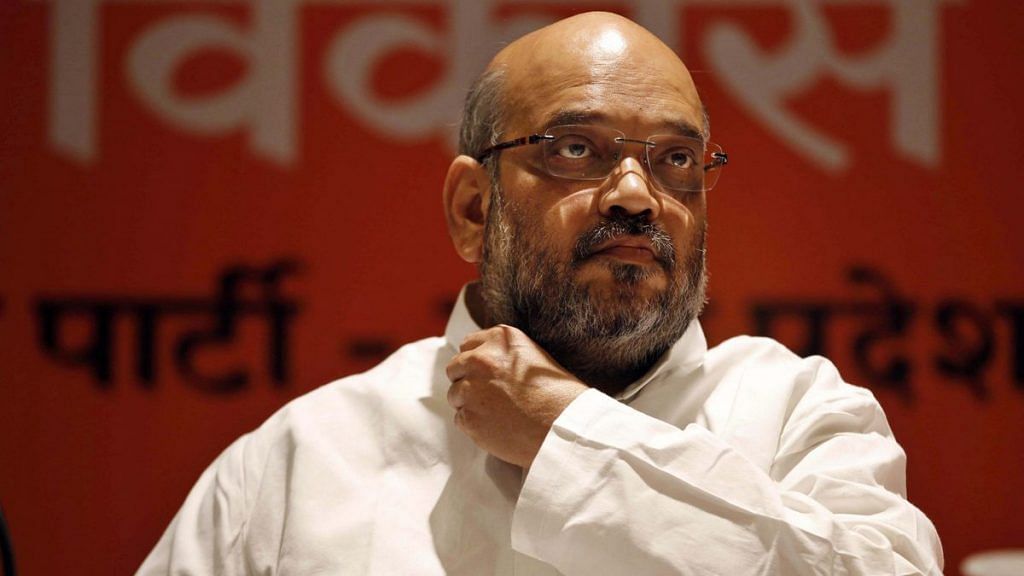The acid test of 2019 will tell if Amit Shah is really the Chanakya he is said to be.
There’s an amazing consensus these days, across political and ideological divides, that the BJP is likely to win around 200 seats or so in the 2019 Lok Sabha elections. Add the NDA allies to that, and the BJP should easily be back in the treasury benches. Recent opinion polls also suggest this as the likely scenario.
Some feel that without a majority, Narendra Modi can’t be Prime Minister. The alliance will demand a change of guard. Modi has been the ruthless strongman that small parties don’t like. People within his own party also feel diminished by the centralisation of power in the Prime Minister’s Office. Such critics underestimate the ability of Modi to be a pragmatist when he needs to be, and his ability to woo people when he needs them. The best example is how he got the opposition’s big hope, Nitish Kumar, to join the NDA last year.
Also read: Modi-Shah-Bhagwat play good cop-bad cop to win 2019 elections
The precedents of past coalition governments tell us that Modi is safe even if the BJP’s 2014 tally gets reduced by 110, and comes down to 172. Allies and regional parties are more transactional than anything else. In exchange for plum ministries, they’ll be happy to work with Modi, asserting themselves more than they did earlier.
Even if the BJP loses a third of its 282 seats, credit will go to Brand Modi for staying on top despite double anti-incumbency in most of the country. If people are willing to vote Modi back to power even though they can’t list a single concrete achievement of his government, that will only be thanks to the charisma and popularity of the Prime Minister.
Chanakyaneeti or plain luck?
However, losing a third of the 2014 tally will make a lot of people question whether party president Amit Shah is really the ‘Chanakya’ he has been made out to be. Amit Shah’s smart strategies, his supporters argue, have led to the BJP’s victories as much as Brand Modi. We have been told a lot of stories about Amit Shah’s booth management, his check-mating of rivals with clever campaigns, his no-nonsense approach to getting things done, his cracking the whip to make party colleagues burn the midnight lamp, his ability to create an aura of invincibility around his party, and his micro-caste games coupled with good, old communal polarisation.
But there are Amit Shah sceptics too. It is possible to make a case that Amit Shah is a manager and an executor gifted with very lucky circumstances. These circumstances are: Brand Modi, the RSS cadre, and a rudderless Congress party. If you have these three things coming together, do you really need to be a Chanakya?
Also read: Why Amit Shah and BJP’s Mission 350 for 2019 looks unreal
Furthermore, Amit Shah has been the bad cop in the Modi-Shah duo. It is Amit Shah whose wrath allies and disgruntled party leaders are known to face. He is not the RSS’ own man either. The RSS usually likes to have one of their own as party president, something they tried to do after the 2014 results but failed under Modi’s pressure.
Acid test
For these reasons, the 2019 elections are more about Amit Shah than Narendra Modi. In 2014, Amit Shah managed only the critical state of Uttar Pradesh. But now he’s the party’s national president, and a wildly successful one. His biggest challenge yet is the 2019 general election. Narendra Modi still gets very high ratings, not least because ‘There Is No Alternative’. This is Amit Shah’s moment to shine, to show he really is a modern-day Chanakya.
It’s relatively easy to be a challenger and present every election as a revolution in the making. It’s tough to beat anti-incumbency, especially given the Himalayan expectations raised by the Modi campaign in 2014. The BJP’s victories in state after state present the challenge of double anti-incumbency before it. Some attrition in the BJP’s vote-share is expected. After all, the BJP can’t possibly win every single seat in Gujarat and Rajasthan the way it did last time in 2014. It is definitely not going to win 70+ of 80 seats in Uttar Pradesh.
If the BJP has to return to power with a clear majority of its own, where will the seats come from? Will minor increases in east India (West Bengal, Odisha, Assam) really make up for the losses in other states?
Also read: BJP’s Mission 2024: Prime Minister Amit Shah?
That is the challenge before Amit Shah. Modi may manage to return to 7, Lok Kalyan Marg by appeasing some regional satraps. But questions will be asked of Amit Shah and his supposed invincibility. His position as party president may become untenable, but he’s already a Rajya Sabha member and could be made a top minister in the Modi government. He does have such ambitions himself. Nevertheless, he may find it difficult to retain that halo around him.
(Obligatory disclaimer: This assessment is based on the current political environment. Things could change a lot over the next six months – in any direction.)
